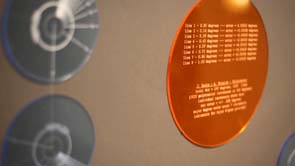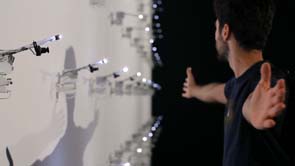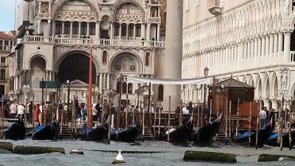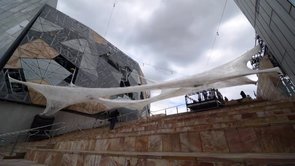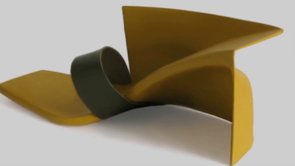URBAN LEGENDS 13 X 26min
TRAILER
|
ep1
Zaha Hadid Architects - Patrick Schumacher - Joint Managing Partner
Dame
Zaha Mohammad Hadid, DBE (born 31 October 1950) is an Iraqi-British architect.
She received the Pritzker Architecture Prize in 2004—the first woman to
do so—and the Stirling Prize in 2010 and 2011. Her buildings are distinctively
futuristic, characterized by the "powerful, curving forms of her elongated
structures" with "multiple perspective points and fragmented geometry
to evoke the chaos of modern life".
|
|
ep2
Fernando Botero & Jemima Wyman
"Fernando
Botero's distinctive style of smooth inflated shapes with unexpected shifts
in scale is today instantly recognizable. It reflects the artist's constant
search to give volume presence and reality. The parameters of proportion
in his world are innovative and almost always surprising. . Today Fernando
Botero divides his time between Paris, New York and Tuscany. His paintings,
sculptures, and drawings are exhibited and represented in museum collections
throughout the world."
Jemima Wyman Jemima Wyman is a contemporary artist who lives and works between Brisbane and Los Angeles. Wyman completed her Bachelor of Fine Arts (in Visual Arts) with Honors at the Queensland University of Technology. In 2007, she graduated with a Master of Fine Arts from The California Institute of Arts in Los Angeles; this study was made possible with the generous support of an Anne and Gordon Samstag Scholarship. In 2005 CamLab was formed, a collaboration between Wyman and Anna Mayer. Recently they participated in the Engagement Party series at the Museum of Contemporary Art, Los Angeles. Wyman’s individual art practice incorporates various mediums including installation, video, performance, photography and painting. Her most recent artworks utilize these mediums to specifically focus on visually based resistance strategies employed within protest culture and zones of conflict. These works aim to explore the formal and psychological potentiality of camouflage and masking in reference to collective identity.
|
|
ep3
SophiaVari-Botero
"Born
in 1940 in Vari near Athens. Lives and works in Paris and Pietrasanta
in Italy Figurative at her beginnings as sculptress in 1975, Sophia Vari
gradually finds an intense plentitude in freeing herself from the subject
in order to measure herself against Time and Space. She discovers with
passion the structure of the planes, the monumental. Her forms becom tangled,
gather themselves, soar skywards, kink, unfold in extension, merge in
ease. As Greek, she refuses what is approximate and her sense of perfection
leads her to a rigour in her studies and search (her numerous journeys
incite her to). Though abstract, her sculptures keep from her original
land a certain classicism.
|
|
ep4 AEDES
[Berlin] & Timo Toots [Estonia]
Aedes was founded in 1980 by Kristin Feireiss and Helga Retzer († 1984) in Berlin-Charlottenburg as the first private architecture gallery in Europe. In memoriam Kongresshalle Berlin was the title of the opening exhibition, which became a groundbreaking success. In 1985 the architecture forum Aedes West moved to the S-Bahn vaults at Savignyplatz. In 1995, under the name of Aedes East, another branch was opened in Hackesche Höfe in Berlin-Mitte by Kristin Feireiss together with her partner Hans-Jürgen Commerell. Since 1996, the team is reinforced by Ulla Giesler, cultural scientist.. Timo Toots Timo Toots (EE) has been producing interactive art projects that analyze, comment on and reflect upon developments in Information Society. Memopol-2 is a social machine that maps the visitor’s information field. When an identification document such as a national ID card or a passport is inserted into it, the machine starts collecting information about the visitor from (inter)national databases and the Internet. The data is then visualized on a large-scale custom display. People using the machine will be remembered by their names and portraits. The Cyrillic spelling of the installation’s name refers to George Orwell’s concept of Big Brother from his dystopian novel 1984. Over the past decades, technology has transformed the surveillance of society. When surfing the Internet, paying with an ATM card or using an ID card, people leave their digital traces everywhere. The Internet and social networks gather and provide a great deal of personal information, and a person’s profile is no longer constituted by his or her physical being alone. Background checks through Internet search engines and social network sites have become routine. Memopol-2 enables us to make a thorough background check on ourselves, mirroring our virtual image.
|
|
ep5 Peter
Eisenmann [USA] & Alessandro Ciffo
Peter Eisenmann [Architect] Peter Eisenman (born August 11, 1932) is an American architect. Eisenman's professional work is often referred to as formalist, deconstructive, late avant-garde, late or high modernist, etc. A certain fragmenting of forms visible in some of Eisenman's projects has been identified as characteristic of an eclectic group of architects that were (self-)labeled as deconstructivists, and who were featured in an exhibition by the same name at the Museum of Modern Art. The heading also refers to the storied relationship and collaborations between Peter Eisenman and post-structuralist thinker Jacques Derrida.[1] Peter Eisenman's writings have pursued topics including comparative formal analyses; the emancipation and autonomization of the discipline; and histories of Architects including: Giuseppe Terragni, Andrea Palladio, Le Corbusier and James Stirling. While he has been referred to as a polarizing figure,[citation needed] such antagonistic associations are likely prompted by Colin Rowe's 1972 criticism that the work pursues physique form of European modernism rather than the utopian social agendas (See "Five Architects," (New York: Wittenborn, 1972)) or more recent accusations that Eisenman's work is "post-humanist" (Perhaps because his references to the Renaissance are 'merely' formal). While his apathy towards the recent "green" movement is considered polarizing or "out-of-touch", this architect-artist (with drawings held by major collections) was also an early advocate of computer aided design. Eisenman employed fledgling innovators such as Greg Lynn and Ingeborg Rocker as early as the 1989.[citation needed] Despite these claims of polarity and autonomization, Eisenman has famously pursued dialogues with important cultural figures internationally. These include his English mentor Colin Rowe, the Italian historian Manfredo Tafuri, George Baird, Fredric Jameson,[citation needed] Laurie Olin, Rosalind Krauss and Jacques Derrida.[2] In addition to his vast literary contributions (as editor, curator, and writer) and professional practice, Eisenman's reputation as a critic and professor of architecture is similarly famed.. Alessandro Ciffo [Furniture] Born in Biella, near Turin, in 1968, he joined the world of design and plastic materials only in 1997. Self-teaching and self-production are the key words of his artistic journey, based on the extreme research for the potentialities of silicone n his one and only medium n, which is the only material capable of fully expressing his emotions. With an outstanding technical control, mastered through tireless experimentations and endless patience, Alessandro creates artefacts that cannot be easily classified, as they are a crossroads between art and design. In a riot of bright colours, vivid whites and absolute blacks, a humble material like silicone grows to be poetry, just like the finest chinaware, the most precious woods and marbles. Alessandro is a blend of many characters, which are usually separate in our contemporary world: a workman, an artist, a designer and a manufacturer who makes his own products. Alessandro is a modern alchemist, capable of transmuting matter into material through inventionand wit, even capable of turning it into the setting of his projects, with the intention of arousing emotions. His last artistic year saw Alessandro exhibitingat the Plart Museum in Naples; his new sofa, made of air and silicone, which was presented at the Sandretto Re Rebaudengo Foundation during Artissima, will be exhibited for one year at the Triennale of Milan, within the show "Quali cose siamo" ("the things we are"), edited by Alessandro Mendini.
|
|
ep6 Michal Fronek [Czeck], Joe Davis [USA] Joe Davis (US) is an artist, researcher and scientist who works at, among other places, MIT’s Department of Biology. He has developed new biological art forms and numerous uncategorizable works at the nexus of art and science. It sounds like science fiction, but it is not. On planet Earth, sophisticated manufacturing processes with full-fledged assembly lines have been running in many different kinds of factories for hundreds of millions of years. Nature evolved biological techniques for large-scale production and manufacturing of a huge variety of specialized materials long before human beings ever existed. Homo sapiens, in turn, have historically exploited many such natural factories to obtain a long list of essential commodities simply because comparable materials could not otherwise be efficiently produced. Even today, biologically assisted methods of production are often put to use with relatively little understanding of the underlying chemical and molecular operations. In recent decades, science has revealed details about some of these operations. Since nature is almost always much more efficient than human industry, researchers are focusing on various biological processes that can be put to work for humanity. The promise of this research is that microbial machinery will eventually carry out many operations now carried out by heavy industry, but with fewer resources and without environmental pollution. Biological Radio addresses this interface of biology and technology. Michal Fronek Michal Fronek was 1966 born in Prague 1988 - 1994 studied at Prague Academy of Arts, Architecture and Design in the Department of Architecture and Design led by Prof. Arch. PhDr. Šípek 1990 - with Jan Nemecek founded design group "Olgoj Chorchoj" at summer workshop of Vitra Design Museum in Weil a/R 1990 - 1993 foundation of "Artel" s. r.o., producing objects of outstanding Czech designs of the 20th century 1999 - with Jan Nemecek co-director of industrial design studio at Prague Academy of Arts, Architecture and Design
|
|
ep7 Ortner
& Ortner [Vienna] & Maki Namekawa [Japan]
Prof. Laurids Ortner, Prof. Manfred Ortner, Laurids: Studied architecture at the Vienna University of Technology (TU Wien).Co-founded the architect and artist group Haus-Rucker-Co in Vienna in 1967. Professor at the University of Art and Industrial Design in Linz from 1976–87. Since 1987, Professor of architecture at the Art Academy Düsseldorf. Manfred: Studied painting and art education at the Academy of Fine Arts Vienna. From 1971–87 Atelier Haus-Rucker-Co in Düsseldorf with Günter Zamp Kelp and Laurids Ortner. Since 1994 Professor of Design at the architectural school FH Potsdam. Maki Namekawa: Deep Space
Music brings together sound and image, music and computer animation in
a way that transforms the projection space into a setting for intimate
experiences. In it, Japanese pianist Maki Namekawa will play a program
of works by three visionary composers who are also regarded as great thinkers.
Her piano concert musically celebrates the 60th birthday of Ryuchi Sakamoto
(JP) and Philip Glass’ (US) 75th, and commemorates the 100th anniversary
of the birth of John Cage (US). Prix Ars Electronica prizewinner Canda?
?i?man (TR) and a crew from NOHlab/Plato Media Lab (TR) will contribute
an extraordinary live visualization. In order to provide Ms. Namekawa
with latitude for spontaneous improvisation, ?i?man and friends will be
working live in real time, though, in doing so, they’ll have recourse
to a repertoire of prepared graphic elements that are the outcome of an
intensive process of encounter with the respective pieces of music.
|
|
ep8 Beate Einen [Norway], Adi Hoesle [GERMANY], Francesca Fabbri [Ravenna] Beate Einen In 2008 Beate Einen Glass & Design was established to design and produce a range of work from glass tableware and lighting design to one-of-a-kind original sculptures. Even though Einen produces most of the work herself, she also pulls together master craftsmen, designers and engineers who can meet the demands of larger projects. Adi Hoesle Adi Hösle: Paint pictures at a computer without the use of your hands, keyboard or mouse. Brain Painting lets you produce images with the conscious activity of your brainwaves, which a brain-computer interface (BCI) and special software translate into actual pictures. The principle is: painting by thinking. And this opens up previously unimaginable expressive possibilities—for example, for paraplegics. What’s behind it is a psychological research approach in use at the University of Würzburg, which artist Adi Hoesle (DE) has been investigating to find out which brainwaves or neuronal patterns are best suited to creating art. Francesca Fabbri Francesca Fabbri was born in Bologna in 1963. She lives and works in Ravenna. She studied at and was awarded a diploma from the Institute of Mosaic Art and in 1987 graduated with 1st class honours from the Academy of Fine Arts in Ravenna. In 1988 she founded the AKOMENA studio, a design centre and workshop for contemporary mosaic, dedicated both to architecture and interior design, in continuous pursuit of an aesthetic that is both disciplined and sublime.
|
|
Andreas Salvetti [Italy] & Seiko Mikami [Japan] Andreas Salvetti [Tuscany] Born in Bozzano Lucca in 1967, Italian sculptor and designer Andrea Salvetti studied architecture at the University of Florence under fellow artisan Guido Cristofani. Salvetti began his ongoing collaboration with Dilmos Milano in 1996 with the exhibition of the aluminu-cast Monozoo chair-sculpture collection at Salone del Mobile. Salvetti is known for designs and furniture-sculptures inspired by the wonder of the natural world, often cast in his mediums of choice; aluminum and bronze. He also explores the interaction between food and art, often with interactive, edible sculptures. Notable projects from his ouevre include L’Albero [Tree], Tronchi [Trunk], L’apparita [Apparition], and a series of aluminum, cloud-like sculptures called Domestic Nature (2012). He works with a variety of furniture companies, and has designed pieces for both private residences and public spaces. Seiko Mikami [interview with Soichiro Mihara and speech by Andreas Broeckmann] Seiko Mikami [interview with Soichiro Mihara and speech by Andreas Broeckmann] Seiko Mikami’s large installation “Desire of Codes” demonstrates how the boundaries between the body of data in the virtual world and the physical body in the real world are becoming blurred in the context of Information Society. The nightmarish setting of this interactive work consists of three parts: a white wall on which 90 insect feeler-like objects with build-in surveillance cameras are mounted (Ninety Wriggling Wall Units); six giant robot arms equipped with video cameras and laser projectors hanging from the ceiling (Six Multi-perspective Search Arms); and a round projection surface 3.5 meters in diameter. This Compound Eye Detector Screen resembles an insect’s multifaceted eyes. Visitors become cognizant of being in the viewfinder of a perfect piece of surveillance machinery. Highly sensitive cameras and microphones register the slightest movement and sounds beyond the range of human hearing. Whatever is registered is stored in a high-performance databank that is the actual core of “Desire of Codes.” On the large screen, installation visitors experience the real-time projections of their own images; these sequences are interspersed by older footage within the system as well as images from surveillance cameras in public places worldwide.
|
|
ep10
Peggy Guggenheim & Shen Shaomin "Philip Rylands, Peggy Guggenheim Venice
|
|
ep11
Hans Hollein & David Elliott "Hans Hollein [Vienna] |
MASTER










